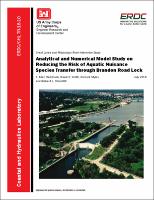Please use this identifier to cite or link to this item:
https://hdl.handle.net/11681/27815Full metadata record
| DC Field | Value | Language |
|---|---|---|
| dc.contributor.author | Hammack, E. Allen | - |
| dc.contributor.author | Smith, David S. | - |
| dc.contributor.author | Stockstill, Richard L. | - |
| dc.contributor.author | Styles, Richard | - |
| dc.date.accessioned | 2018-07-27T16:36:10Z | - |
| dc.date.available | 2018-07-27T16:36:10Z | - |
| dc.date.issued | 2018-07 | - |
| dc.identifier.govdoc | ERDC/CHL TR-18-10 | - |
| dc.identifier.uri | http://hdl.handle.net/11681/27815 | - |
| dc.identifier.uri | http://dx.doi.org/10.21079/11681/27815 | - |
| dc.description | Technical Report | en_US |
| dc.description.abstract | The Great Lakes and Mississippi River Interbasin Study (GLMRIS) is a U.S. Army Corps of Engineers study to evaluate methods of preventing the movement of aquatic nuisance species (ANS) movement between the Great Lakes and Mississippi River basins through aquatic connections. This report is an assemblage of ideas, preliminary hydraulic calculations, and numerical model evaluations that serve as part of the development of an ANS flushing system for Brandon Road Lock on the Illinois Waterway. Four flushing system designs and operations are presented. An analytical description of each lock flushing system design and numerical model results of those designs when applied to Brandon Road Lock are presented. Further, justifications and considerations of a physical model study of any lock flushing design that is chosen for construction are presented. This report is an overall commentary on design ideas and considerations for modeling the flushing rate of the lock chamber. The hydraulic details of lock flushing are outlined with the significant parameters of each lock flushing alternative highlighted. Numerical model results are presented to quantify the effectiveness of each lock flushing concept considered in this study. | en_US |
| dc.description.sponsorship | Prepared for U.S. Army Corps of Engineers, Chicago District, and U.S. Army Corps of Engineers, Rock Island District under Project 451647, "Brandon Rd - Great Lakes/Miss RVR Interbasin Study (GLMRIS)", Project 45617, "Brandon Rd. Lock Flushing Numerical Model", and Project 114597, "Interbasin Control GL, MR Species" | en_US |
| dc.description.sponsorship | Great Lakes and Mississippi River Interbasin Study Program (U.S.) | - |
| dc.description.tableofcontents | Abstract ii Figures and Tables v Preface viii Unit Conversion Factors ix 1 Introduction 1 1.1 Background 1 1.2 Objective 4 1.3 Approach 5 1.4 Other flushing considerations 5 2 Literature Review of Lock Flushing Ideas 7 2.1 Previous lock flushing ideas 7 2.2 Considerations for flushing aquatic nuisance species (ANS) 8 2.3 Brandon Road Lock details 8 3 Lock Flushing – Analytic Description 13 3.1 Advection-diffusion equation 14 3.2 Turbulence and mixing 17 3.2.1 Plug flow 17 3.2.2 Well-mixed flow 19 3.2.3 Advection-dispersion flow 20 3.3 Momentum jets 21 3.4 Stagnant regions (dead zones) 24 4 Lock Flushing Concepts 25 4.1 Hydraulic design of flushing systems 25 4.2 Lock flushing systems 25 4.2.1 Type 1 lock flushing concept (existing filling and emptying system) 26 4.2.2 Type 2 lock flushing concept (lateral flushing manifold) 30 4.2.3 Type 3 lock flushing concept (culverts through sill) 32 4.2.4 Type 4 lock flushing concept (continuous flow below chamber) 35 4.2.5 Type 5 lock flushing concept (redesigned filling and emptying system) 36 5 Numerical Modeling Process 38 5.1 Governing equations 38 5.2 Modeling procedure 40 6 Numerical Model Setup 41 6.1 Type 1 lock flushing concept model geometry 42 6.2 Type 2 lock flushing concept model geometry 43 6.3 Type 3 lock flushing concept model geometry 44 6.4 Type 3r lock flushing concept model geometry 45 6.5 Type 5 lock flushing concept 46 7 Numerical Model Results 47 7.1 Type 1 lock flushing concept 50 7.2 Type 2 lock flushing concept 59 7.3 Type 3 lock flushing concept 59 7.4 Type 3r lock flushing concept 69 7.5 Type 5 lock flushing concept 77 7.6 Lock flushing numerical model results summary 87 8 Physical Model Considerations 89 8.1 Kinematic similitude 89 8.2 Dynamic similitude 90 8.3 Similitude for lock models 90 8.4 Model-prototype comparison 93 8.5 Similitude for mixing models 95 8.6 Hawser forces during flushing 96 9 Further Research – Prototype and Physical Model Testing 100 9.1 Prototype tests 100 9.2 Physical model experiments 100 9.2.1 Safety 100 9.2.2 U.S. Army Corps of Engineers (USACE) regulations 101 9.2.3 Numerical modeling uncertainties 101 9.2.4 Physical model tests 102 9.3 Tow effects 103 10 Summary and Recommendations 106 References 109 Appendix A: Eisenhower Lock Flushing System Drawings 112 Appendix B: Computational Meshes 114 Appendix C: Type 2 Fixed Lid Model Results 123 Report Documentation Page | - |
| dc.format.extent | 137 pages / 22.37Mb | - |
| dc.format.medium | PDF/A | - |
| dc.language.iso | en_US | en_US |
| dc.publisher | Coastal and Hydraulics Laboratory (U.S.) | en_US |
| dc.relation.ispartofseries | Technical Report (Coastal and Hydraulics Laboratory (U.S.));no.ERDC/CHL TR-18-10 | - |
| dc.rights | Approved for public release; distribution is unlimited | - |
| dc.source | This Digital Resources was created in Microsoft Word and Adobe Acrobat. | - |
| dc.subject | Hydraulic structures | en_US |
| dc.subject | Illinois Waterway (Ill.) | en_US |
| dc.subject | Introduced organisms | en_US |
| dc.subject | Locks (Hydraulic engineering) | en_US |
| dc.subject | nonindigenous aquatic pests | en_US |
| dc.title | Analytical and Numerical Model Study on Reducing the Risk of Aquatic Nuisance Species Transfer through Brandon Road Lock | en_US |
| dc.type | Report | - |
| Appears in Collections: | Technical Report | |
Files in This Item:
| File | Description | Size | Format | |
|---|---|---|---|---|
| ERDC-CHL TR-18-10.pdf | 22.91 MB | Adobe PDF |  View/Open |